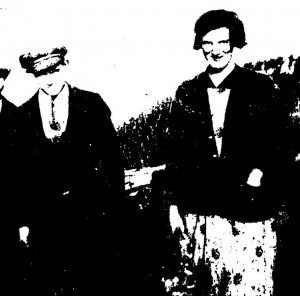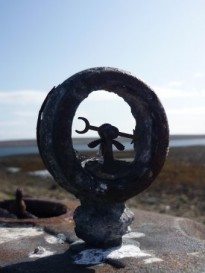Sandy Barnett died on 5 April 1941 as a result of an air attack on the SS Rattray Head, eight miles ENE of Aberdeen. The Rattray Head was a 496 ton steam cargo ship on a voyage from Leith, her home port, to Stromness, Orkney. “Young Sandy”, so called to distinguish him from his father, was a lamp trimmer, that is a member of the deck crew responsible for navigation and other lights. He was 33 and the only son of Sandy and the late Jemima Barnett.
My father had a prodigious memory and knew all about the sinking of the Rattray Head, which would have happened about four months before he was called up. How I wish I could remember all he said. It seems that as the crew made for their lifeboat the German plane returned and strafed the ship with machine gun fire. Sandy may have gone back to the bridge for something, possibly a knife to cut the lifeboat’s ropes, but at that point he was fatally wounded. Quite unusually for an Orcadian seaman, he was a strong swimmer so could have stood a reasonable chance of survival but for the shooting.
His body washed ashore at Crail, Fife, some way down the east coast of Scotland, and that is where he is buried (scroll down the link page to see his gravestone). He is also named on his parents’ gravestone in Osmondwall Kirkyard, Longhope, Orkney. When my parents visited Crail in the 1950s they met by chance someone who had been at the service when Sandy’s body was buried. Quite a poignant meeting as Sandy was my father’s favourite cousin, though about 14 years older than him.

Sandy Barnett and his sister Ellen
I guess it was probably that kind of liking you have for older cousins who are kind and very tolerant despite your youth. I have only been able to find one photo of him, with his sister Ellen whom I remember very well. Unfortunately it is a fairly poor photo.
The captain of SS Rattray Head, a Shetland man, Matthew Leask from Bressay, and the fireman, Charles V Tookey, were also lost. They are among almost 24,000 merchant seamen and fishermen from WW2, many of whom have no grave, commemorated on the Tower Hill Memorial in London. The Rattray Head’s section of the memorial is on this page – you will need to scroll down.
It seems that only those three were lost but I have yet to establish how many other crew there were as I write this, almost 74 years to the day after the event.
For more information on the ship itself and the wreck, see www.wrecksite.eu
Battleships-cruisers.co.uk lists merchant ships and fishing boats lost as a result of enemy action in WW2, three on 5 April 1941 alone.


Matthew Leask was my grandfather! I am James Leask and you can call me on 07507 512474.
Many thanks for making contact Jim. A few links on this blog no longer working, I'll need to get that sorted.
Your relative sounds great! Please call…
Hi, yes, hoping 2019 will be calmer.
Charles Victor Tookey was my husband's grandfather. His wife and son still live and remember him. I know the ship's story from him telling me. Thank you for sharing.
Thanks for commenting. I'd be very interested to learn more of what your husband's family knew of the events.
Hi, Jim Leask here, Matthew's grandson. I lost my father at Christmas. Almost 98. Give me a call anytime: 00447507512474.
Hi, I was searching for information on the SS Rattray Head & came across your site and thought you may be interested in the following, which is a transcript obtained from the National Archives, of the official interview of the ship's Chief Officer, R. Stoker, made shortly after the sinking. We believe that the wreck of the Rattray Head lies 7.4 miles east of Aberdeen (at N57d08.783' W01d49.418') however at a depth of 96 metres, it is unlikely that we will ever dive her.
CONFIDENTIAL
REPORT OF AN INTERVIEW WITH MR. R. STOKER
CHIEF OFFICER OF THE S.S. “RATTRAY HEAD”
SHIPPING CASUALTIES SECTION
TRADE DIVISION
9TH April 1941
MR. STOKER:
We were bound from Leith to Stromness with 440 tons of bricks and general cargo. We were armed with 1 Lewis gun, a Strip Lewis and a Holman Projector. The confidential books were in a weighted bag, but they went down with the ship. The number of crew, including the Master and 1 Naval Gunner, was 11, of whom 3 are missing.
We left Leith on 5th April and joined up in Convoy E.C.2 off May Island. My section of the convoy had to join some other ships. When we reached May Island there was a strong head wind and heavy weather, causing us to straggle from the convoy. After this we did not sight any escort and proceeded independently. That night about 2000 when I was on deck there [was] considerable enemy air activity on our port beam. I could hear the bombs dropping and could see the tracer bullets. About 2045 everything was quiet and nothing occurred until 2130 when we were in a position 8 miles E.N.E from Aberdeen, we were attacked by an enemy aircraft which was either a J.U. 88 or H.E.11. The sea at the time was rough with wind N.E. about force 6; the weather was squally with varied visibility. I was below at the time and the first thing I heard was the roar of aeroplane engines followed by three dull thuds, which were bombs hitting the ship. I am told that the aeroplane approached from astern, dropping 1 bomb behind the funnel, one in front of the bridge and another on the fo’castle head.
The ship took a sudden list to port. I came up on deck immediately and tried to get the raft over from No. 2 hatch , the listing of the ship making it easier to slip it over. The aeroplane then returned and flew over the ship, machine gunning us along the starboard side, turned round, came back and machine gunned us along the port side, finally disappearing to the East.
A Fireman who was asleep in the forward part of the ship was not seen again, and fire had by this time broken out in the fo’castle head. We had not managed to get the raft over, so I jumped on to the bridge, got an axe and cut the raft clear; 8 of us then got on to this raft. The Skipper and Bo’sun said that they would try and get a boat away. When we were clear I thought I saw the Skipper walking on the starboard side of the ship, but the next time I saw him he was on a small raft.
The ship was sinking rapidly, so I tried to pull as far away from her as possible as she was listing heavily and I was afraid she would come over on top of us. We had no paddles and were doing the best we could with our hands and feet to get away from the ship. We managed to get within about 6ft of the Skipper, but just then the ship sank and the suction pulled us right back to the position in which the ship had gone down. We pulled back again, and having found a paddle and an oar, we returned to the spot in which we had last seen the Skipper. We found a raft, but I do not know if it was the one on which the Skipper had been, but although we called and shouted we could get no reply.
We pulled for about half an hour but were unable to make much headway. The moon came out and we were able to see the land which heartened us considerably. One ship came quite close to us, but although we called and shouted, we were unable to attract his attention. Our flashing lamp had been damaged, but during the time we were on the raft I was able to repair it and when the trawler RONONIA came along , I was able to attract her attention. She came over to us, picked us up and landed us at Methil.
Thank you very much for sharing. A great deal of interest there.